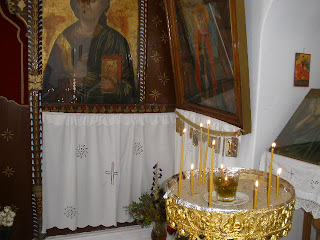I rented a car for $30 Euro/tax, insurance included. Even though I have rented in Ithica, Santorini and Crete, this business insisted on keeping my drivers license!
Note: IT’S AN ISLAND, WHERE AM I GOING TO GO TO STEAL A CAR?!!
Okay, so car ready I found out that the town of Parakia was only 8 miles away. Being the largest Port on the Island of Paros, the town was slightly larger than Naussoa but not by much. Again, all business, as built around the harbor and into a maze behind the first line of building.
The church stopped me in my tracks. NOT because it was so beautiful, but because it looked more like an old fortress. THIS is it? I went in thru the huge gate only to find that somewhat of a fortress had been built around the church. Inside the museum I saw the rendering of what it looked like after building. And yes, it was breathtaking. At the entrance I bought a couple candles. One I lit for my father, who died in May. And although he was a Mennonite and this is a tradition we do not follow, but it felt right for me. The other I lit for Tim Soth, my friend who died it a car crash when we were all about 17. His parents would appreciate it I think.
According to the information I picked up and looked up, the construction of the Church of 100 Gates (or Doors) dates back to the 6th century, but the inspiration dates further back to the 4th century when it was founded by St. Helen, the mother of Constantine. According to legend, St. Helen was forced to put in at Paros during a storm, while on a pilgrimage to find the path to the True Cross. As is the Greek custom when in trouble at sea, she vowed to build a church on this spot but died before this plan could be realized.
The emperor Justinian saw Helen's plans to completion in the 6th century.
One thing that interested me was the history of the builder. Since I had loved the Agia Sofia eight years ago in Istanbul, I wanted to see this church base on the legend. As it is recalled; legend surrounds this pretty church of pupil surpassing master, and ensuing tragedy. The church was built by Ignatius, who was a pupil of the architect of the famous Agia Sofia in Constantinople (Istanbul), Isidore of Miletus. Isidore attacked Ignatius in a fit of jealous rage when he saw the beautiful church and tried to push Ignatius off the roof. In the ensuing struggle, both men fell to their deaths. Ignatius and Isidore are immortalized in stone in the courtyard in front of the church.
Another legend surrounds the gates, or doorways. Ekatontapylani was made up of three interlocking buildings, with 99 doors and windows. According to legend, when the 100th door is found, Constantinople (Istanbul) will return to the Greeks. In the 10th century, the church was restyled in the shape of the Greek cross.
An icon of the virgin can be found on the wooden iconostasis which is worshipped for its healing powers. Nearby the icon, a footprint set in stone is said to belong to the island's patron saint Agia Theoktisti.
As a young woman, in the 9th century, Theoktisti was captured by pirates. She escaped and fled to Paros where she lived alone in the woods for 35 years. When a local hunter found Theoktisti, she asked him for some communion bread. He gave her the bread and she laid down and died. Realizing she was a saint, the hunter took her hand as a relic, but he found he couldn't leave the island until he reunited her hand with the body. The severed hand relic is displayed in the church.
I picked out a small cross necklace in the gift shop to remember this spot. And, while I was there, I could not find the 100th door. I guess Turkey is off the hook for a while.




No comments:
Post a Comment